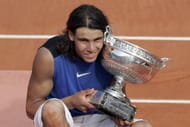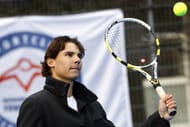What does it take to be the Greatest of All Time (GOAT), besides having a great forehand, backhand and serve? Among all-time greats, longevity is certainly the key: Pete Sampras won 14 Grand Slams over 14 years and Roger Federer won 17 Grand Slams in 14 years. To go down in history, a player in the Open Era needs to compete at the top of his or her game for an extended period of time. Time itself rewards those who are patient and seize opportunities as they come by – for instance, Federer won the 2009 French Open because of Soderling’s upset over Nadal. This article will be turning back the clock to the 2000′s to examine Rafael Nadal’s rocky, but legendary career.
Federer’s Legacy
“The maestro”, as Roger Federer has become known, is perhaps the most consistent player the world has ever seen. Since 1998, Federer has never had a serious injury, meaning one that would impact his tour schedule. Federer’s 35 consecutive quarterfinals and 23 consecutive semifinals are a testimonial to his mastery over his game.
Federer’s amazing longevity can be credited to his attacking style and grace on court. His serve and volley skills and large selection of shots allow Federer to finish points faster and put more pressure on his opponents. In addition, the maestro schedules well to focus on Grand Slams and the Master series to lower the strain on his body.
The King of Clay’s Knee Injury History
It is not hard to imagine why Nadal’s career is infested with injuries and timeouts. Tennis is a sport where one just needs to hit one more shot than one’s opponent. The Spaniard’s defensive game capitalizes on chasing down every ball and wearing down his opponent one shot at a time. Here is a breakdown of Nadal’s tennis career vis-a-vis his knee troubles, since 2005.
October 2005 – February 2006
2005 was a monumental year for Nadal. The clay season saw Nadal win the first of his seven French Open titles. His foot injury, however, prevented him from playing in the season-ending Masters Cup in China. The teenager, at the time, quickly made a successful comeback and knocked out Federer in Dubai in 2006. He also won his second French Open and made it to his first ever Wimbledon final a few months after his comeback.
May 2009 – September 2009
Nadal’s 2009 year had many ups and downs. Upsetting Federer in the 2009 Australian Open, Nadal was surprisingly knocked out in the French Open by Robin Soderling (a match that Nadal would remember and turn the tables on in 2010). Nadal, consequently, reached a breaking point and took four months off to recuperate.
According to The Telegraph, the King of Clay said “I think I tried everything; I did my best to arrive at Wimbledon in my very best condition but Hurlingham was the last test and, though I didn’t feel terrible I was not close to my best.” Nadal’s comeback again saw the Spaniard go on an impressive run to take away the No. 1 ranking from Federer. Nadal consequently won the French, Wimbledon and US Open to complete his career golden slam in 2010.
June 2012 – February 2013
In the words of John McEnroe, Wimbledon 2012’s second round featured the greatest upset in tennis history – Nadal lost in a sentimental five set match to Lukas Rosol. After Wimbledon, the Spaniard had his longest career hiatus: he missed two consecutive slams in a seven month period.
Should fans be worried? No. As shown from 2005 and 2009, Nadal knows how to make a comeback. Only 26 years old, Nadal has a lot of potential to dominate the racquet sport once again. After all, Andre Agassi showed the world that an “old man” (28 years old +) can still win slams.
Having already reached the finals at Chile Open, fans can expect a career turning point from Nadal.
What has the Spaniard learned?
Nadal, an eleven time Grand Slam champion, is only 26 years old and has the potential to perhaps usurp Federer’s record. Coming off a seven month hiatus, the Spaniard will be focusing on getting back to his original form and sustaining his 2010 form to win more slams.
Tactics – Nadal has recently given up on the racquet that he has used since he was 12 years old and has asked to modify the strings and frame for his comeback. Why? More topspin. This may sound surprising to those already aware of Nadal’s astonishing amount of topspin, which helped him dominate on clay.
This can only mean one thing – Nadal wants to finish points earlier and hit more winners with low error rates from the baseline. At this point, Nadal will try to ease the strain on his knees by attacking more often. In Nadal’s recent match with Federico Delbonis at Chile Open, the audience once again saw the old Nadal who artistically creates impossible angles at the net and hits huge forehands that push the opponent 10 feet from the baseline.
Scheduling – Nadal, similar to Federer, will plan out his tour schedule better, by playing more on clay and less on hard courts. Uncle Toni, Nadal’s relative and coach, has spoken in public about how hard courts are more demanding on players’ bodies. For this reason, the King of Clay chose his first tournaments in 2013 to be on clay. It’s possible that Nadal will cut back on minor hard court events from this point on.
Attitude – Nadal, known for his tenacity to play every point as if it’s his last, has developed a positive outlook on matches. As champions get older, the top concerns are always an ageing body and poor motivation. The Spaniard, however, is clearly different. His passion always leaves a deep impression on his fans. He is currently 6 Slams away from Federer. Nadal will be hungry to equal the maestro’s legacy.
Collision course between Nadal and the top players in tennis:
Nadal will be training to get back in sublime form and make history. Expect the seven-time French Open champion to work his way up gradually and dominate the Masters tournaments on clay, starting from Monte Carlo and going all the way up to the French Open. Let’s cheer on Spain’s Raging Bull as he tries to make tennis history.
Who Are Roger Federer's Kids? Know All About Federer's Twins


